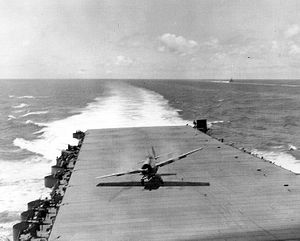This last weekend, the United States Navy celebrated the 75th anniversary of the Battle of Midway. Although its memory is often overshadowed by commemorations of the D-Day invasion, Midway remains one of the most pivotal moments of World War II. Midway was the world’s largest naval engagement since Jutland (if we don’t count Pearl Harbor), although it would be superseded by the great carrier battles of 1944.
The basic tactical situation at Midway is well-known; the Americans enjoyed the advantages of land-based air (aircraft launched from Midway itself) as well as intelligence regarding the timing and disposition of Japanese forces. The Japanese enjoyed a huge numerical advantage in surface ships, and a smaller advantage in carrier aircraft. The American advantages held; a series of raids against the Japanese strike force left it unbalanced, and eventually vulnerable to dive bomber strikes that sank four fleet carriers.
Both of the forces at Midway included a mix of new and legacy vessels. As we contemplate how both China and the United States have developed integrated, long-range naval construction plans, it’s worth thinking about how these earlier fleets combined old and new elements. Even simple variables such as the age of a ship can matter a great deal to combat effectiveness, more so than is easily described by a list of offensive and defensive systems. Newer ships tend to include improvements, based on changes in technology and on lessons learned, that defy easy categorization. This includes even ships of the same class; the first Arleigh Burke Flight III destroyer will likely differ in consequential ways from the final Arleigh Burke Flight III destroyer. Age can also reduce the effectiveness and fighting ability of a ship, depending on how well it has been maintained and how vigorously it has served.
At Midway, three Yorktown class aircraft carriers, completed in 1937, 1938, and 1941, made up the core of the U.S. task force. The eight ship U.S. Navy cruiser screen was considerably older, including ships from as early as 1929. The 15 destroyers mostly came from various classes built from the mid-1930s on. The Japanese carrier force consisted of four fleet and two light carriers; the fleet carriers entered service in 1927, 1928, 1937, and 1938, although the earlier two ships were substantially refitted in the 1930s. The Combined Fleet included several capital ships that had entered service in the 1920s, or before; the four Kongo class fast battleships had served during World War I. Most of these ships had benefited from at least one major reconstruction, however. For comparison, the oldest capital ship at the Battle Jutland was nine years old, and most were considerably newer than that. On the other hand, the oldest capital ship currently in U.S. service is the 42-year-old USS Nimitz; key technologies have matured, enabling architects to envision much longer lifespans for vessels.
It’s also worth noting that Midway did not resemble the tactical situations that either the IJN or U.S. Navy had envisioned, or prepared for, in the years before the war; both forces still expected surface combat between battleships to play a central role in any major naval clash. The U.S. Navy would fight (and win) the great battles of 1944 with capital ships that had less than a year of service, and that in most cases were optimized for the kind of fighting they actually engaged in.
In many cases, those ships would continue to serve for decades, albeit in roles that their architects had not always expected. This may be the biggest lesson of Midway; winning organizations take pains to maintain their flexibility in the face of technological and strategic changes. And even when they do so, decisive victory requires more than a bit of decisive luck.

































